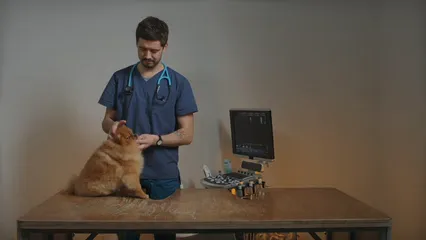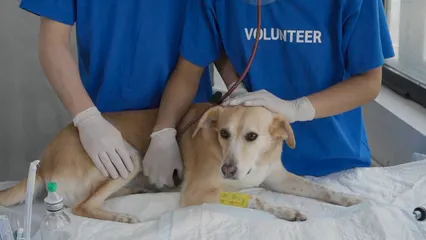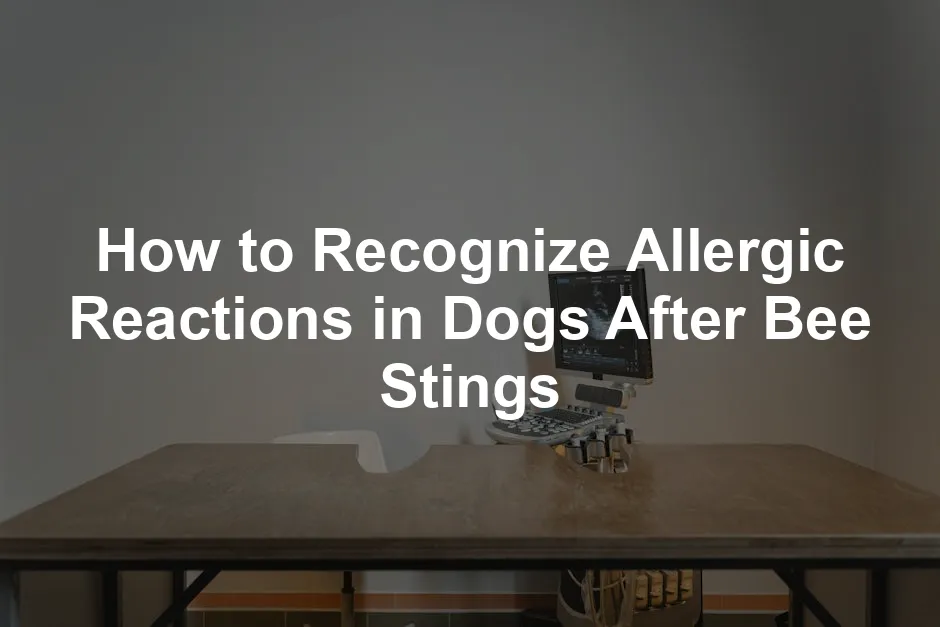Introduction
Bee stings can happen to our furry friends. Dogs, curious by nature, often encounter bees while exploring outdoors. While most stings result in mild discomfort, some dogs may have allergic reactions. Recognizing these symptoms early is crucial. Quick identification can lead to effective treatment. This article aims to educate dog owners on spotting and responding to allergic reactions in dogs after bee stings.

Understanding how to recognize allergic reactions in dogs after bee stings is vital for their safety. Learn more about these reactions here.
Summary and Overview
Bee stings are common in dogs, especially during warmer months. These stings can lead to varying reactions, from minor pain to severe allergies. After a sting, it’s essential to monitor your dog closely for symptoms. Knowing when to seek veterinary assistance can save your dog’s life. Statistics show that about 1-5% of dogs may experience severe allergic reactions. This article will guide you through recognizing signs of bee stings and allergies.

And while we’re on the topic of your dog’s health, how about being prepared for those unexpected emergencies? A well-stocked Dog First Aid Kit could make all the difference when accidents happen. You never know when your pup might need a little extra TLC!
Understanding Bee Stings and Allergic Reactions
What Happens When a Dog is Stung by a Bee?
When a bee stings your dog, it injects venom via its barbed stinger. The stinger often remains in the skin, releasing venom continuously. This venom contains proteins that can trigger allergic responses. A dog’s immune system may react to this venom, causing various symptoms. Most stings occur on the face, paws, or inside the mouth.
Statistics indicate that bee stings are a significant cause of emergency visits for dogs. It’s crucial to act quickly and remove the stinger if possible. This action can reduce the amount of venom injected. Observing your dog for any changes in behavior is vital. If you notice excessive swelling or signs of distress, seek veterinary care immediately. Keeping dogs away from areas where bees are active can help prevent these incidents. Always keep an eye on your pup during outdoor activities!

Speaking of outdoor activities, if your adventures take you near water, consider getting your dog a Dog Life Jacket. It’s a lifesaver—literally! Keep your pup safe while they splash around and have fun.
Recognizing Symptoms of Bee Stings in Dogs
Common Symptoms Following a Bee Sting
When your dog gets stung by a bee, you’ll likely notice some immediate signs. Common symptoms include swelling at the sting site, pain, and excessive drooling. You might see your pup licking or pawing at the affected area, which can indicate discomfort.
Bees often target specific areas, such as the face, mouth, and paws. If your dog suddenly whines or yelps while exploring, a bee sting might be the cause. Look for swelling around the muzzle or lips—this is particularly concerning and can quickly escalate.

Other signs to watch for include redness and heat at the sting site. If your dog becomes more vocal than usual or seems restless, it’s a signal that something is wrong. After outdoor activities, keep a close eye on your dog to catch these symptoms early. Prompt action can make all the difference in ensuring their comfort and safety.
And while you’re at it, why not invest in a Pet Thermometer? It’s a handy tool for quick checks after those outdoor escapades!
Signs of Mild Allergic Reactions
Some dogs may exhibit mild allergic reactions after a bee sting. Symptoms can include localized swelling around the sting site and hives appearing on the skin. You might also notice your dog being slightly lethargic or showing reduced interest in play.
These reactions typically occur within minutes but may develop later. If you see a small amount of swelling, monitor your dog closely. Licking at the site or scratching can worsen the situation, leading to further irritation.

If symptoms persist or worsen, it’s essential to consult your veterinarian. They can provide guidance and possibly recommend antihistamines if needed. Keeping a watchful eye during this period can help catch any changes in behavior or physical condition.
Speaking of antihistamines, make sure you have some Antihistamine for Dogs on hand. It can be a game-changer for those unexpected allergic reactions!
Signs of Severe Allergic Reactions (Anaphylaxis)
Anaphylaxis is a severe allergic reaction that can be life-threatening for dogs. Symptoms often develop rapidly and include difficulty breathing, severe swelling, and vomiting. If your dog has pale gums or exhibits weakness, these are critical signs that warrant immediate attention.
Anaphylaxis may occur within minutes of a sting or can be delayed. It’s important to recognize symptoms such as rapid panting, excessive drooling, or signs of distress. If you notice these symptoms, take your dog to the vet immediately. Statistics show that about 1-5% of dogs experience anaphylaxis after bee stings. Understanding these signs can be crucial.

Early intervention can be vital, as this condition can escalate quickly. Don’t hesitate to seek emergency care if your dog shows any signs of severe reactions. Prioritizing your dog’s health and safety is essential in these situations.
Steps to Take if Your Dog is Stung by a Bee
Initial Actions Post-Sting
If you discover that your dog has been stung by a bee, your first step is to remain calm. Your dog will pick up on your anxiety, which can make them more stressed. Gently examine the area where the sting occurred. If you see a stinger, carefully remove it using a credit card or tweezers. Avoid squeezing it, as this can inject more venom.
Next, apply a cold compress to the affected area. A clean cloth soaked in cold water or a wrapped ice pack can help reduce swelling. Keep the compress on for about 10 minutes. This cooling effect will soothe your dog and ease discomfort.

It’s essential to monitor your pet closely during this time. Watch for signs of distress and keep them calm. You can distract them with gentle petting or their favorite toy. If your dog shows signs of an allergic reaction, seek veterinary care immediately. Remember, staying calm is key to helping your furry friend feel better.
And while you’re at it, consider getting some Cold Pack for Injuries. It’s a handy item for those unexpected bumps and bruises!
Monitoring Your Dog for Reactions
After a bee sting, monitoring your dog is critical. Observe them for at least a few hours for any signs of worsening symptoms. Look for swelling, especially around the face or mouth. If you notice significant swelling, difficulty breathing, or excessive drooling, these could be indicators of an allergic reaction.
Keep an eye out for changes in behavior as well. Is your dog restless or unusually lethargic? These can be signs of discomfort or distress. Take note of any abnormalities, like vomiting, diarrhea, or changes in appetite.

Consider keeping a log of any symptoms you observe. This information can be helpful for your vet if you need to seek further assistance. If your dog seems to be getting worse, don’t hesitate to contact your veterinarian. Early intervention can be crucial for your dog’s health.
When to Seek Veterinary Care
Determining the Severity of the Reaction
Knowing when to contact your vet is vital after a bee sting. If your dog has a history of allergic reactions, it’s wise to err on the side of caution. If your dog has been stung multiple times or shows severe symptoms, immediate veterinary care is necessary.
Watch for emergency signs such as difficulty breathing, swelling in the throat, or excessive vomiting. If your dog’s gums appear pale or if they collapse, get to a vet right away. These symptoms indicate a severe allergic reaction known as anaphylaxis, which can be life-threatening.

Even if your dog seems fine initially, continue to monitor them closely. Some reactions can be delayed, appearing hours after the sting. If you have any doubts or concerns, don’t hesitate to call your veterinarian. It’s always better to be safe. Your dog’s health and safety should be your top priority.
Preventing Bee Stings
Tips for Keeping Your Dog Safe
Keeping your dog safe from bee stings is essential. Start by training your dog to avoid areas with flowers. Bees are often buzzing around blooms, making it a probable sting zone. When walking your dog, use a leash to maintain control. This way, you can steer them away from potential encounters.
Avoid letting your dog roam freely in unfamiliar areas. Curious pups might dive into bushes, increasing their chances of getting stung. Instead, stick to safe routes during walks. If you notice bees, redirect your dog’s attention with treats or toys.

Additionally, consider practicing a solid recall command. This can help you call your dog back before they get too close to a bee. Implementing these safety measures can significantly reduce the risk of bee stings. Remember, a little prevention goes a long way in ensuring your furry friend’s safety during outdoor adventures!
And don’t forget about hydration! An Outdoor Dog Water Bottle can be a great companion for hikes and outdoor fun, keeping your pup hydrated while you both enjoy nature!
Conclusion
Recognizing allergic reactions in dogs after bee stings is crucial for their well-being. Monitoring your dog closely after any sting can help catch potential issues early. If you notice signs of distress, seeking veterinary care promptly can save your dog’s life. Prevention is key; keep your dog away from bee-prone areas. The right precautions can enhance your pup’s safety while enjoying the great outdoors. Always prioritize your dog’s health and happiness!
FAQs
What should I do if my dog is stung by a bee?
Immediately remove the stinger and monitor for symptoms. If your dog shows signs of an allergic reaction, contact your vet.
Can I give my dog antihistamines after a bee sting?
Consult your vet first. Some antihistamines may be safe, but proper dosage is essential to avoid complications.
How can I tell if my dog has been stung?
If you suspect your dog has been stung by a bee, watch for specific signs. Common symptoms include excessive licking of the affected area and noticeable swelling. Your dog may paw at their face or the spot where they were stung. You might also notice drooling or whining, indicating discomfort.
What are the signs of anaphylaxis in dogs?
Anaphylaxis is a severe allergic reaction that can occur after a bee sting. Symptoms often appear rapidly and include difficulty breathing and severe swelling. If you notice your dog has pale gums, excessive drooling, or appears weak, these are critical signs. Vomiting or diarrhea may also indicate a severe reaction.
How can I prevent my dog from getting stung by bees?
Preventing bee stings involves proactive measures. First, teach your dog to avoid flower beds, where bees are often found. Use a leash during walks to maintain control and direct your dog away from buzzing insects. Avoid letting your dog roam freely in unfamiliar areas, as curiosity can lead to bee encounters.
Is a bee sting on a dog an emergency?
Not all bee stings require emergency care, but certain situations do. If your dog has a history of allergic reactions, it’s essential to be vigilant. Multiple stings or a sting inside the mouth can be serious. Watch for symptoms like difficulty breathing or excessive swelling around the face and neck.
What should I do if my dog gets stung inside the mouth?
If your dog is stung inside the mouth, immediate action is vital. First, stay calm to help your dog remain calm. Look for signs of swelling or difficulty breathing. If you notice these symptoms, take your dog to the vet right away, as swelling can block their airway.
Please let us know what you think about our content by leaving a comment down below!
Thank you for reading till here 🙂
All images from Pexels





